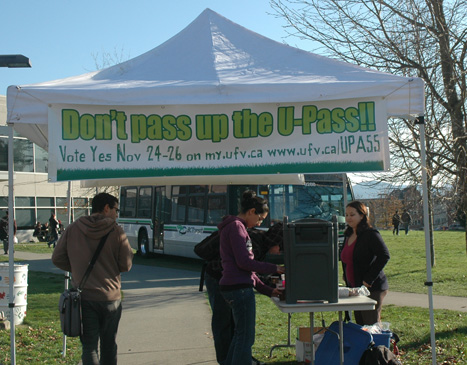By Joe Johnson (The Cascade) – Email
Print Edition: June 20, 2012
The My Safe Ride Home (MSRH) service provided by the Student Union Society (SUS) is slowly being phased out due to contractual difficulties. The MSRH service was an addition to the U-Pass, which provided students with a one-use $25 credit towards a cab expense.
When the U-Pass referendum passed back in 2009, the idea was for it to be a $40 subsidized entry for two key services, transit and recreational facilities in the Abbotsford, Mission and Chilliwack cities. But there was also one other purpose to the card, and that is to have the inclusion of value-added services – one of which is known as My Safe Ride Home (MSRH).
The SUS’s communications administrator Jhim Burwell explained the way the program was designed to work. “If a student found themselves out in a situation that they really needed to get home quickly and safely, they would be able to call one of the partner cab companies and act the My Safe Ride Home,” he said. “The cab company would come and put them at the top of the priority list right behind doctors and nurses, dispatch a cab and pick them up – take them straight home.”
In addition, MSRH was designed to bring revenue back to the SUS and minimize the U-Pass cost.
The program was a valuable service according to Burwell. “I will say, uncategorically, that [MSRH] is a great program and it’s definitely a program I would invest in for my children and myself”.
The program will soon be removed, however. “As of April 2013 the My Safe Ride will have been phased out of the U-Pass,” Burwell said.
The reason behind that decision—which came to light a year after its actual implementation—was due to confusion of the original financial negotiations with the Aislinn Education & Safety Foundation, whom the SUS is partnered with on this venture.
The actual cost for the U-Pass design was to be $30 for transit and recreational facilities, roughly $5 for administration, and $5 for the value-add on.
At the launch of the program, the SUS believed that every member of the student body would contribute $5 into building a capital fund. Upon that, only first-time registered students would then contribute $5. Being that the cab ride had a value of $25 the SUS would need five semesters of contributions to break even for each successive round of new entrants. The plan was to average it out so that students who stayed longer than the needed break-even period would make up for those students who would leave before then. If the students left the University without using that $25 credit, it would be split as profit between the SUS and Aislinn.
At least that was the understanding of the SUS.
The Aislinn view (and the reality of the contract) was that at the end of every 365-day period the program would be refreshed – not the end of each student’s UFV career. This meant that students would continue paying for those other three semesters without coverage – that is unless they somehow knew to reregister.
It was only when the SUS received, in October 2010 one year after MSRH’s implementation, a cheque for roughly $104,000, that the misunderstanding began to become apparent. Still, the mistake was only realized after the money was reinvested back into student programs such as clubs & associations and grants.
Aislinn then received the other half of the fund ($104,000), in accordance with the contract SUS had signed.
While the fact that MSRH was designed to turn a profit for Aislinn may be disturbing to some, Burwell stated “To call that disturbing is disingenuous because the My Safe Ride Home program was never considered to be anything less than a revenue-generating program that they were out trying to make money on their own. The same as … BCAA would.”
When the difference in the contractual interpretation was realized within the SUS they moved to renegotiate the program. With a somewhat different composition of members, the board that had brought in MSRH as a service and a potential revenue stream for the student society, had to find a compromise between the parties.
However, playing into further contract complications was also the fact that the SUS hadn’t, at the time of original negotiations, implemented a functioning way to track the exit of students from the program.
Burwell made it clear that with the new negotiations they “were working on a system with the registrar that would say ‘if a student hadn’t registered for three or four consecutive semesters, they hadn’t paid the U-Pass fee for three or four consecutive semesters, that was when they became non-redeemed.’”
But as those renegotiations with Aislinn continued, it became clear that it wasn’t going to be feasible to meet the Board’s original vision of the program unless the SUS returned the $104,000. Instead, Burwell made an effort to try and restart the program at the beginning of September of the following year, and extend the contract. Ultimately though, this ended up not taking place as other details further convoluted the process.
“The problem was entirely one of being able to afford the program within the confines of the U-Pass,” he said. “We figured we were spending somewhere between $50 and $60 per student per semester on the U-Pass and that’s obviously untenable.”
In the end, this meant that MSRH was an expense and that the SUS wasn’t seeing the proper revenue being generated which would bring down the U-Pass cost to that $40 student fee.
Still, Burwell believes that had the original SUS members behind the conceptualization of the MSRH program stayed on board “that eventually all those mechanisms would have fallen in place.”
Given that the MSRH wasn’t defined in the referendum, bringing it to an end will not require students to go back to the polls.


